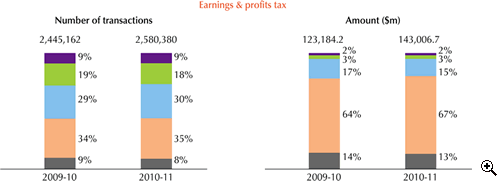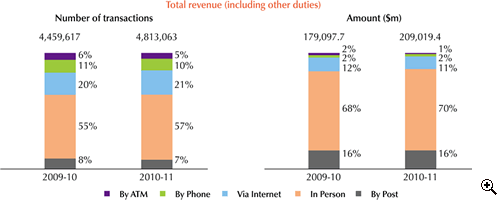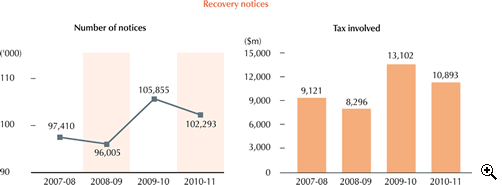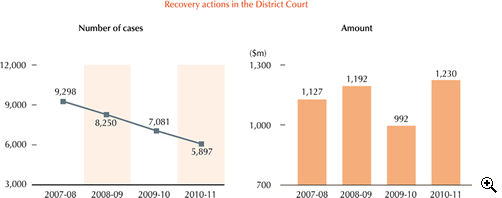
Revenue collected by the Inland Revenue Department includes tax, additional tax, surcharge and fines.
Schedules 13 and
14 provide details of additional tax, surcharge and fines imposed by the Department in respect of earnings and profits tax during 2010-11.
Collection of Tax
A taxpayer can choose to settle his tax liability by various payment methods, including electronic payments (by phone, bank ATM or the Internet), payment in person or payment by post. Paying tax by electronic means has been well received by the public. For earnings and profits tax, 57% of the payment transactions in 2010-11 were made through electronic means, representing an increase of about 74,000 cases or 5% over last year.
Figure 25 shows the respective percentages of the different payment methods used by taxpayers under earnings and profits tax and total revenue.
Figure 25 Payment methods

 Refund of Tax
Refund of Tax
Refunds were made to taxpayers for various reasons, such as overpayment of tax or revision of an assessment. 523,164 refund cases were made in 2010-11, representing an increase of 2.4%. The total amount of refunds was $10.7 billion, representing an increase of $0.4 billion or 3.9% as compared with the previous year (
Figure 26).
Figure 26 Tax refunds
| |
|
2009-10 |
|
2010-11 |
|
| |
Type of tax |
Number |
|
Amount ($m) |
|
Number |
|
Amount ($m) |
|
| |
Profits tax |
37,303 |
|
6,128.9 |
|
35,606 |
|
6,672.1 |
|
| |
Salaries tax |
406,387 |
|
2,660.2 |
|
420,915 |
|
2,438.9 |
|
| |
Property tax |
17,223 |
|
130.7 |
|
16,742 |
|
128.7 |
|
| |
Personal assessment |
23,912 |
|
246.4 |
|
24,499 |
|
247.9 |
|
| |
Others |
| 25,848 |
 |
|
|
| 1,148.7 |
 |
|
|
| 25,402 |
 |
|
|
| 1,225.9 |
 |
|
|
| |
Total |
|
|
|
|
|
|
|
|
Recovery of Tax in Default
Taxpayers should pay tax on or before the due date shown on the demand notes issued to them. The vast majority of taxpayers settle their tax liabilities in a timely manner.
A late payment surcharge of 5% will generally be imposed where tax is in default. If tax debts remain outstanding for more than six months after the due date, the Department may impose a further surcharge of 10% on the total unpaid amount.
Any tax in default is immediately recoverable. Recovery notices can be issued to third parties (including employers, bankers and other parties owing money to or holding money on behalf of the defaulting taxpayers) to effect collection. Actions may also be commenced in the District Court.
Figure 27 summarises the recovery actions taken by the Department. Upon entry of judgment, a defaulting taxpayer becomes liable to legal costs and interest on judgment debt for the period from the date of commencement of proceedings to the date of full settlement in addition to the outstanding tax.
Figure 28 shows the legal costs and judgment interest collected during 2010-11.
Figure 27 Recovery action

 Figure 28 Legal costs and judgment interest collected in 2010-11
Figure 28 Legal costs and judgment interest collected in 2010-11
| |
|
$ |
|
$ |
|
| |
Court cost |
|
|
|
|
| |
|
2,130,476 |
|
|
|
| |
|
| 46,773 |
 |
|
|
2,177,249 |
|
| |
Fixed cost |
|
|
940,832 |
|
| |
Judgment interest |
|
|
|
|
| |
|
3,673,212 |
|
|
|
| |
|
| 29,303,487 |
 |
|
|
| 32,976,699 |
 |
|
|
| |
Total costs and interest collected |
|
|
|
|
The Commissioner may apply to District Court to prevent a person with tax in default from leaving Hong Kong. The Commissioner has to satisfy a District Judge that there are reasonable grounds for believing that the person intends to depart, or has departed, from Hong Kong to reside elsewhere without paying his tax or furnishing adequate security for payment of such tax, for his issuance of the "departure prevention direction". The relevant legislation also provides that the person concerned may appeal to the Court of First Instance of the High Court against a District Judge's decision.




